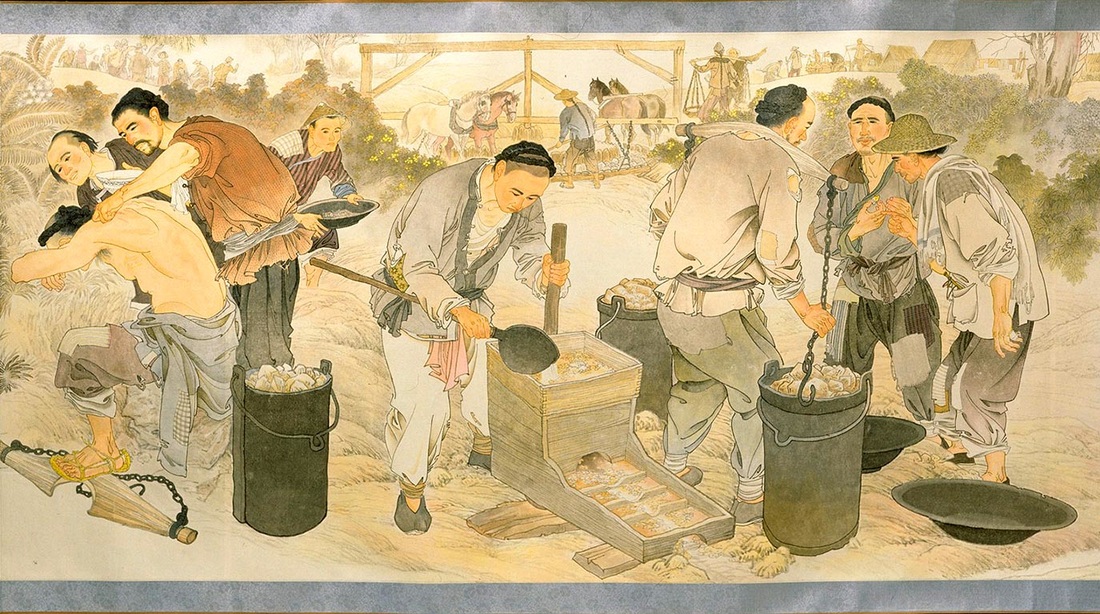Sometimes it’s easy to forget that Daylesford’s very existence is owed to the discovery of gold at Wombat Flat (now mostly underwater at Lake Daylesford!) in 1851. Over the years, the focus of gold mining activity in the district took the form of shallow alluvial, deep lead and quartz reef mining. Historically, the distribution of these sites was extensive with often intensive re-mining occurring.
The recent Victorian Goldfields World Heritage bid has revived interest in this exciting history. https://goldfieldsworldheritage.com.au/
During the heady days of the late 19th century, information about mining and miners took up much of the coverage of the local newspaper and was eagerly read and discussed by all.
From The Daylesford Advocate and Hepburn Courier Thursday 3 January 1860:
MINING REPORT
(Ambrose Johnson, Mining Surveyor)
In the mining population, no visible change has occurred during the month. As near as I can form an estimate, it remains the same as for October, viz: – Europeans 2763, Chinese 926. Machinery at work 59, idle65.
Although the dry season has fairly set in, still its effects have not been greatly felt yet, as most of our old residents know where a good livelihood during summer may be obtained; and on the whole, the general state of mining throughout may be considered satisfactory.
Quartz Mining. – Parker’s Specimen Reef, and Sportsman’s Reef (probably a continuation of the first named), head of Dry Diggings present a very animated appearance, and large stacks of stone, expected to yield handsomely, are ready for crushing.
Mr Wilson’s crushing machine, having undergone thorough repairs has only lately resumed operations and is pronounced to work admirably. On Collier’s Reef, Wombat Hill, Messrs Winter and company are now and again reported to have got some first-rate stone; and on Wombat Reef, the parties at work are getting well paid although no extraordinary yields have come to my knowledge. On Connell’s Reef, Messrs Willard, the only party working, are doing well, working the ground systematically.
A new vein, called the Nuggety Reef, was lately discovered, running nearly parallel to, and about 40 yards west of Connell’s reef. At a depth of 40 feet, the reef was a width of three inches, and the yield was 6 oz per ton. Claims on this line were therefore eagerly sought for.
Puddling and sluicing are fairly at a standstill on account of the initial absence of water in our creeks. During the summer probably new ground will be prospected, as a great number of our puddlers and sluicers are removing towards the outskirts of the division.
Tunnelling has not undergone any visible change by the setting in of dry weather. The stuff is being stacked for next winter, most of the tunnels affording enough water to prospect the stuff before stacking and to wash off the best stuff to support the party. Tunnelling may be considered, for steadiness of yield, and for the length of time it affords profitable employment, as one of our chief resources, although in some instances a very considerable outlay of capital and labour is required before payable gold is obtained.
By 1859 the most significant group of alluvial miners were the Chinese with the mining register figures from that year showing that one third of the total miners were Chinese. Many of them had great success, often to the chagrin of the other miners:
A party of Chinamen, working on the old Gravel Pits lead, yesterday sold to Messrs Wittkowski Bros., two very remarkably shaped nuggets which they had obtained out of new ground. They weigh respectively 9 and 11 ozs. The 9oz nugget is the exact model of a human foot, though in a very small compass, and it is fairly entitled to be classed among Victorian curiosities. The other is of such a grotesque shape that we hardly know how to describe it; it resembles a crocodile in miniature more than anything else we can think of.
From the Daylesford and District Historical Society. https://daylesfordmuseum.net/





